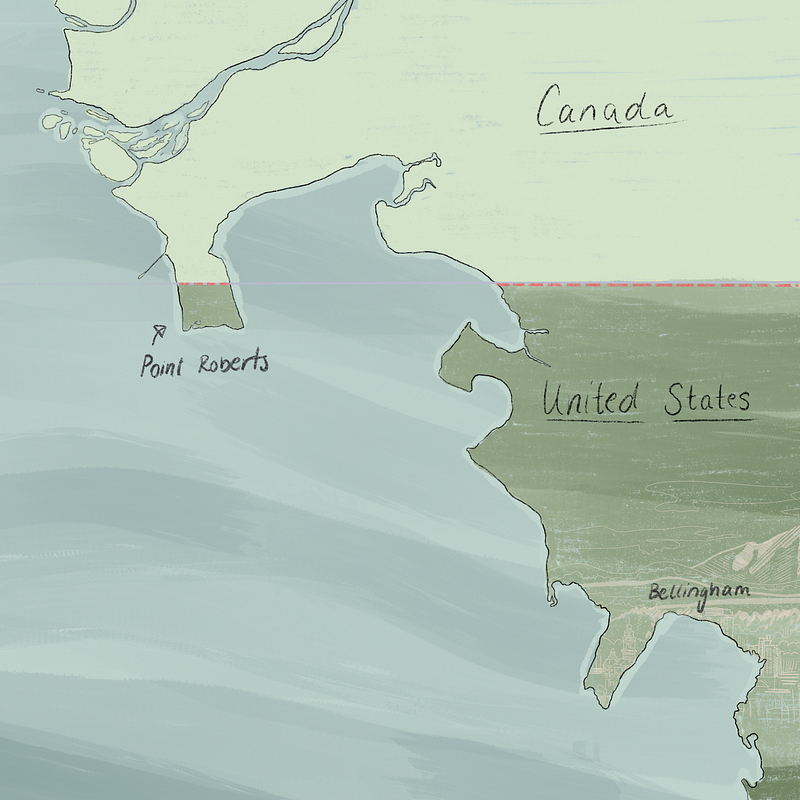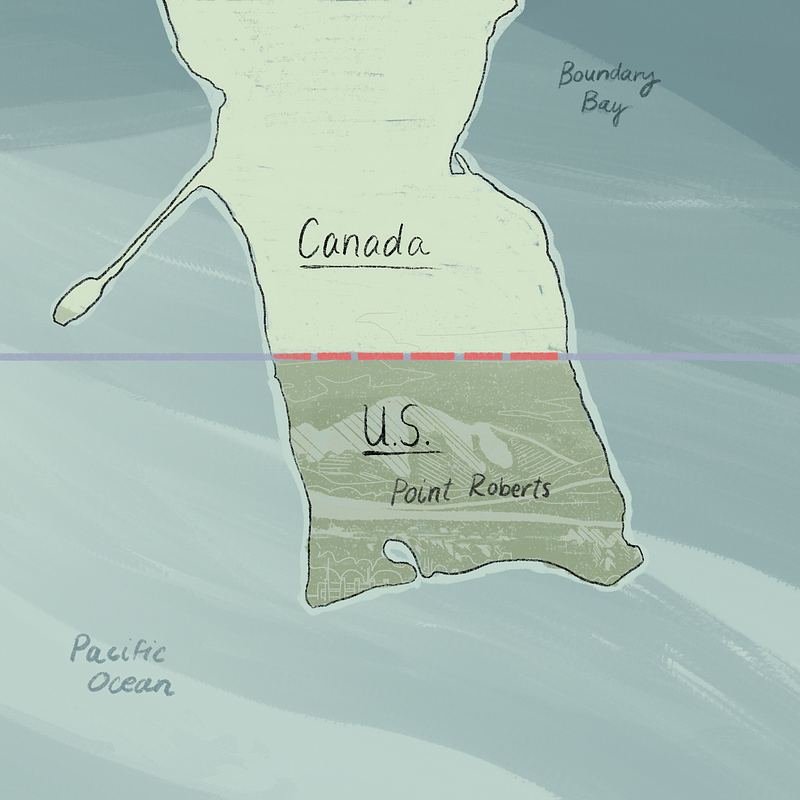Below the 49th Parallel

How COVID-19 border restrictions left a U.S. community stranded and encompassed by Canada.
Story by Hailee Wickersham
A pene-exclave, pronounced by the International Phonetic Alphabet as pɛniˌɛkskleɪv, can be defined as part of a territory in one country that can only be easily accessed by traveling through the territory of another.
Point Roberts consists of roughly 4.8 square miles of land and is surrounded by the crystal blue waters of the Strait of Georgia and Boundary Bay. The town is dotted with cedar tree forests, sandy beaches and sprawling fields. In addition, Point Roberts is home to a population of 1,116 people, according to the most recent census data.
Since the two neighboring countries decided to close their borders on March 21, 2020 due to the COVID-19 pandemic, the residents of Point Roberts haven’t been able to make their dependable commutes into the U.S. or surrounding areas in Canada.
The History
Point Roberts has often been framed by the media as an afterthought or geographical blip made by the British. It has been described in the past as the “fingertip” of the U.S. Yet many readers may not know this was a purposeful decision by British colonials when constructing the 49th parallel that divides Canada from the U.S.
Originally, the region of today’s Point Roberts was discovered and claimed by Coast Salish peoples that were a part of British Columbia’s First Nation tribes, such as the present day Tsawwassen First Nation.
According to HistoryLink, the original Coast Salish tribes such as the Cowichan, Lummi, Saanich and Semiahoo had been in the region for thousands of years before Spanish colonials arrived.
“The Northern Straits Coast Salish community had been living in Point Roberts for about a quarter of the year, every year,” said Mark Swenson, president of Point Roberts Historical Society and author of “Point Roberts Backstory.”

“A lot of the salmon bunch up at Point Roberts and so it was one of the best fishing places on the whole West Coast,” Swenson said.
According to Swenson, the Spanish were the first Europeans to see Point Roberts in 1791 and named the region Punta Zepeda. But the following summer, British Colonial Officer George Vancouver actually set foot on the territory and named the land Point Roberts after his friend Captain Henry Roberts.
Eventually, in 1818, Britain and the U.S. wanted to establish a border that continued out to the ocean to divide their territories. The original U.S.-Canadian border had been drawn from Minnesota to the snow-capped Rocky Mountains, but sharing the land west of the mountain range soon became messy.
After nearly 20 years of negotiations, the two powers decided to scope out the land since no one had explored the region yet. In 1841, the U.S. Navy sent Charles Wilkes to map out the area.
“They thought, ‘OK, if we use the 49th parallel, it’s going to slice off Point Roberts,’ but they didn’t see it as a problem,” Swenson said. “A lot of people believe that they didn’t know the peninsula was there, but that’s false. In fact, it was Wilkes’ maps the U.S. negotiators used, knowing that we had territory close to the Fraser River and they wanted it.”
It wasn’t until 1846 that Point Roberts was officially established.
That year, the Treaty of Washington fully designated the 49th parallel. Ultimately, this gave the British territory and present-day Canada the longest river in British Columbia, the Fraser River.
“So we’re not a mistake — that’s something that I think is really important,” Swenson emphasized.
“A lot of people think that Point Roberts is a mistake and that’s false. They knew we were there.”
Border Closure
On March 21, 2020, the U.S. and Canada mutually agreed to close their border to motor travel due to the ongoing pandemic. Since then, Point Roberts residents have spent most of their days land-locked.
Brian Calder has been president of the Point Roberts Chamber of Commerce for two years and has lived in the town since 1986. His great grandfather settled in Point Roberts in 1896.
Fast forward to 2021 and Calder said the whole area has eerily become a ghost town.
“There’s nobody on the road,” Calder said. “I estimate we had 1,200 people pre-COVID and my best guess is that we are down to around 800 people.”
Further, a large portion of Point Roberts traffic and revenue comes from Canadians crossing the border, mostly during the summer months.
Calder is afraid that Canadians will not return with the same numbers now that the border might be closed for the second summer in a row.
“Our population swells from 1,000 to about 5,000 in the summer, so imagine what that does for the economy because they’re using beaches, barbecuing, or boating and so forth,” Calder said. “I would say our economy is about 90% dependent on Canadians, generally from the lower mainland.”
The town’s two main sources of economic interaction from Canadians are at gas stations and parcel posts. There are over 60 gas pumps and seven parcel post locations for roughly 1,400 residents.
But the town has been on a decreasing economic cycle for the past 10 years, experiencing between 3- 5% of erosion each year, Calder said.
“In [those] 10 years, we had 10 businesses and restaurants close and the travel business is now gone,” Calder said. “The business is gone, never coming back and there’s nothing to replace them. There’s nothing supporting us economically to bring in new people.”
Since the initial border closure, multiple other enterprises in Point Roberts have struggled to stay afloat, such as the marina. With its crescent-shaped design, it’s speckled with rows of sailboats and is one of the most iconic local attractions in the area. The Point Roberts Marina is currently listed for purchase by Windermere Commercial for $25 million.
Zihao Ding is the manager for the Point Roberts Marina and he believes that out of the 1,000 spots for boats to dock, only 200 spots are being used at the marina today. Ding mentioned that revenue declined sharply after the border closed; to keep the marina operating, they had to reduce their staff.
Another industry in Point Roberts that seems to be in danger is banking. In December of last year, one of the two remaining banks shut down its operations from inside the only grocery store in town, the International Marketplace. This merely left one bank as the only in-person location for banking in town.
Ali Hayton is the owner of the International Marketplace. Hayton lives in Mount Vernon, Washington, and commutes once a week across the border to reach her store.
“No other bank will look at the open space until the border opens,” Hayton lamented.
Hayton mentioned that when the border closed, the store went from serving roughly 8,000 weekly Canadian and local customers to around 1,600. But according to the business owner, when Whatcom County opened the ferry to allow Point Roberts residents back into Blaine, Washington, it caused her business revenue to drop another 20%.
“We had to lay off five people,” Hayton said. “We tried to only let go of as many part-time people as we could so all of our full-time employees who were supporting families could keep their benefits.”
More Than a Year Later
The plan for Point Roberts will not be a “one size fits all” solution mainly due to its unique geographic location and its economic dependence on Canada. Even so, there have been a few ideas proposed for its future.
On May 17, the Chamber of Commerce submitted a proposal for a controlled border reopening between Point Roberts and British Columbia. The plan was proposed to Dr. Umair A. Shah, state secretary of health, and Adrian Dix, minister of health in British Columbia.
The letter signed by Calder presents a proposal for a pilot project. The project would allow for the two governments to trial and monitor opening a small portion of the border at Point Roberts before opening the entire border.
Point Roberts is 80% vaccinated and plans are underway to begin vaccinating children who are 12 years of age and older, according to the proposal document. It also states that there has been an extremely low number of COVID-19 cases with only two households that have tested positive.
Based on a poll created by the Delta Optimist, a Canadian news publication, about 83% of the 596 respondents believe that Point Roberts should be used in the pilot project.
While Canadians have been able to fly in and out of the U.S. with a negative COVID-19 test, residents in Point Roberts cannot simply drive across the border to visit a family member or attend an appointment.
Looking at the future, many residents are already excited for when the land travel restrictions are lifted.

Swenson is most looking forward to getting tacos again as there are no Mexican restaurants in Point Roberts. He also hopes his daughter, who currently lives in Japan, can come visit.
For Hayton, she has gotten creative with the empty space the bank left.
“We’ve turned it into a community corner,” Hayton said. “There’s boutique-type stuff that people [in Point Roberts don’t have access to.] So if you need a gift for Mother’s Day, for example, we have some things sourced from local artists.”
As for Calder, he is dedicated to returning Point Roberts to its pre-pandemic economic stability by getting Canadian commerce back.
Multiple petitions have been created on Change.org to urge the Canadian and American governments to open the border. But the Chamber of Commerce has taken a more direct route.
The organization’s petition includes instructions on how to send the document to Sen. Patty Murray, Gov. Jay Inslee, Prime Minister of Canada Justin Trudeau and Premier of British Columbia John Horgan.
Calder reported there has been overwhelming support with 700 signatures sent so far.
As of May 24, Point Roberts received its first formal acknowledgement from the Washington State Department of Health about the town’s dilemma. While a plan is not yet set in stone, Calder is hopeful that after eight months of writing and petitioning in both countries, some progress toward opening the border will be made.
The people remaining in Point Roberts live in what could only now be described as a shell of what the town once was.
Today, many residents recalled that someone could walk the beach or drive the stretch of Tyee Drive without seeing another soul.
Yet, someway and somehow, the residents in the town seem to be brimming with hope that they will meet their Canadian neighbors, families and friends again soon.
